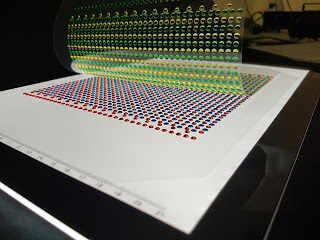Bioprinting Industry Highlights of Q1 2018
New Methods
A team from the University of British Columbia (UBC) Okanagan campus has developed a new technique called direct laser bioprinting (DBLP), which allows researchers to print living tissues instrumental to cancer research. This method entails utilizing a laser diode to photo-crosslink at a wavelength of 405 nm, enabling researchers to print artificial tissues at an unprecedented resolution and level of precision [1]. The tissues printed using this method can also sustain living cells with an unparalleled 95% effectiveness, meaning that cells can successfully survive on the engineered tissue structures [2]. The UBC team postulated and determined that DBLP can be utilized in “cell-laden hydrogel microgrids, hydrogel microwells, cell seeding, and cell encapsulation,” [3] adding to its appeal as a key innovation. According to lead researcher Dr. Keekyoung Kim, these findings have numerous potential applications, “from helping people suffering from ailments such as severe burns or organ failure to creating artificial tissues for research into diseases like cancer” [4]. Learn more about this exceptional discovery at their online publication.
New Materials
There is a constant search for novel bioinks that not only provide structural support but enhances biological function for the desired tissue. Recently, a team of researchers introduced a tyrosinase-doped bioink into the repository of known biomaterials for bioprinting. This group combined gelatin methacrylamide (gelMA) and collagen (Col) and doped the mixture with tyrosinase (Ty) to create a material that would facilitate the regeneration of skin cells [5]. Experimental results suggest that this new bioink can sustain high cellular viability in the formation of epidermal and dermal skin cells, giving it value as a skin bioink in the bioprinting industry [6]. To learn more about this transformative bioink, visit the scientific article here.
Featured Application
What better way is there to get inspiration than from nature? Researchers at the University of Fribourg (Switzerland), University of Michigan, and UC San Diego successfully bioprinted a soft power source that is structurally and functionally reminiscent of an electric eel. To simulate the process of transmembrane transport in electric eels that enable them to generate their own electricity in an artificial device, the team of scientists layered hydrogels with various concentrations of saltwater to achieve increasingly higher voltages, eventually reaching 110 volts [7]. To create the hydrogels, researchers placed gel precursor droplets onto plastic substrates and used UV light radiation to solidify the droplets into gels [8]. They constructed a pathway for generating electricity by rotating saline concentrations and ion-selective gels on the substrates [9]. The findings of this study have immense potential in terms of practical applications and can be utilized in the creation of power sources for implants, such as self-recharging batteries or artificial pacemakers [10]. Read their Nature publication for more information here.
For more bioprinting resources, follow us on Linkedin
A team from the University of British Columbia (UBC) Okanagan campus has developed a new technique called direct laser bioprinting (DBLP), which allows researchers to print living tissues instrumental to cancer research. This method entails utilizing a laser diode to photo-crosslink at a wavelength of 405 nm, enabling researchers to print artificial tissues at an unprecedented resolution and level of precision [1]. The tissues printed using this method can also sustain living cells with an unparalleled 95% effectiveness, meaning that cells can successfully survive on the engineered tissue structures [2]. The UBC team postulated and determined that DBLP can be utilized in “cell-laden hydrogel microgrids, hydrogel microwells, cell seeding, and cell encapsulation,” [3] adding to its appeal as a key innovation. According to lead researcher Dr. Keekyoung Kim, these findings have numerous potential applications, “from helping people suffering from ailments such as severe burns or organ failure to creating artificial tissues for research into diseases like cancer” [4]. Learn more about this exceptional discovery at their online publication.
There is a constant search for novel bioinks that not only provide structural support but enhances biological function for the desired tissue. Recently, a team of researchers introduced a tyrosinase-doped bioink into the repository of known biomaterials for bioprinting. This group combined gelatin methacrylamide (gelMA) and collagen (Col) and doped the mixture with tyrosinase (Ty) to create a material that would facilitate the regeneration of skin cells [5]. Experimental results suggest that this new bioink can sustain high cellular viability in the formation of epidermal and dermal skin cells, giving it value as a skin bioink in the bioprinting industry [6]. To learn more about this transformative bioink, visit the scientific article here.
What better way is there to get inspiration than from nature? Researchers at the University of Fribourg (Switzerland), University of Michigan, and UC San Diego successfully bioprinted a soft power source that is structurally and functionally reminiscent of an electric eel. To simulate the process of transmembrane transport in electric eels that enable them to generate their own electricity in an artificial device, the team of scientists layered hydrogels with various concentrations of saltwater to achieve increasingly higher voltages, eventually reaching 110 volts [7]. To create the hydrogels, researchers placed gel precursor droplets onto plastic substrates and used UV light radiation to solidify the droplets into gels [8]. They constructed a pathway for generating electricity by rotating saline concentrations and ion-selective gels on the substrates [9]. The findings of this study have immense potential in terms of practical applications and can be utilized in the creation of power sources for implants, such as self-recharging batteries or artificial pacemakers [10]. Read their Nature publication for more information here.
For more bioprinting resources, follow us on Linkedin




Comments
Post a Comment